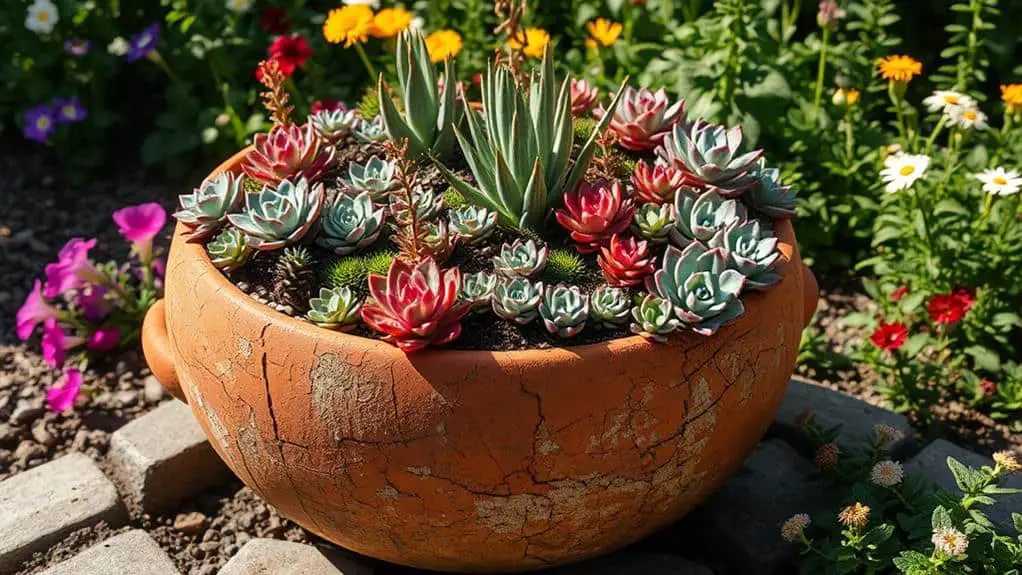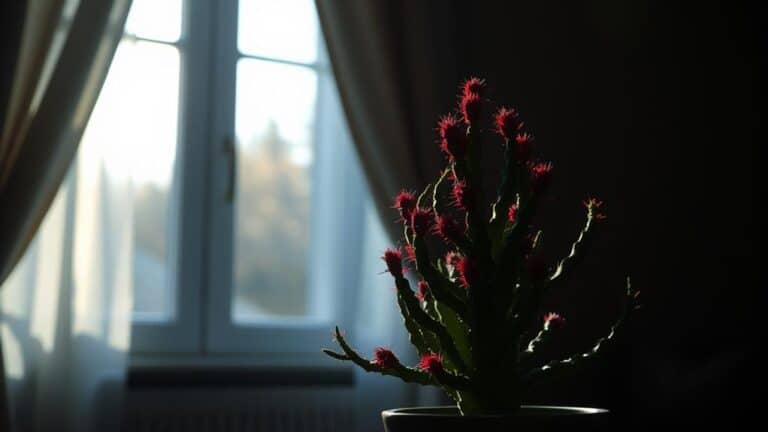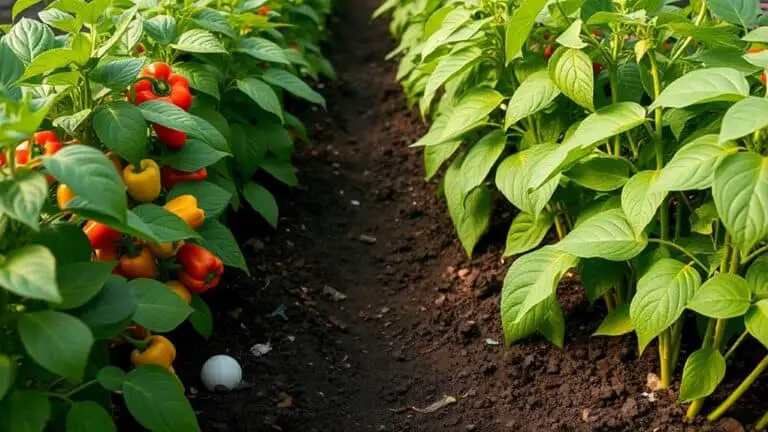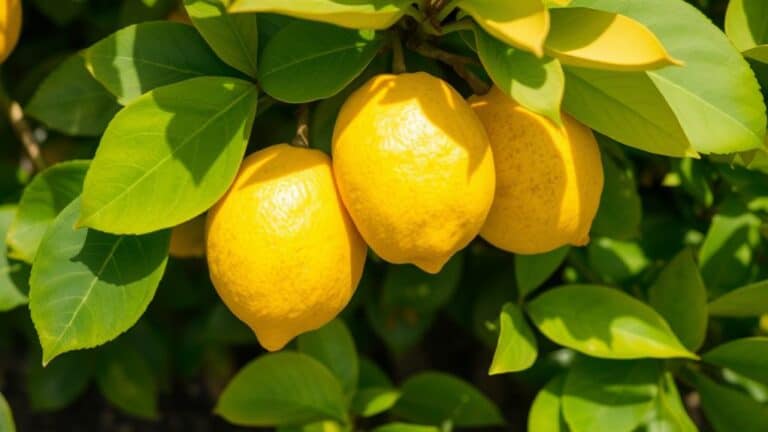Turn Your Cracked Pot Into A Stunning Succulent Garden
Ever look at a cracked pot and think it's destined for the trash? Think again. I've discovered that with a bit of creativity and the right approach, you can transform those broken pieces into a stunning succulent garden. It's an eco-friendly way to repurpose what you might have discarded, and the results can be both striking and rewarding. Imagine combining the vibrant colors of Echeveria and Sedum with the architectural beauty of Haworthia. But it's not just about picking the right plants; there's a whole art to arranging them and ensuring they thrive. Curious about how to get started? Let's explore the steps together.
Repurposing Cracked Planters
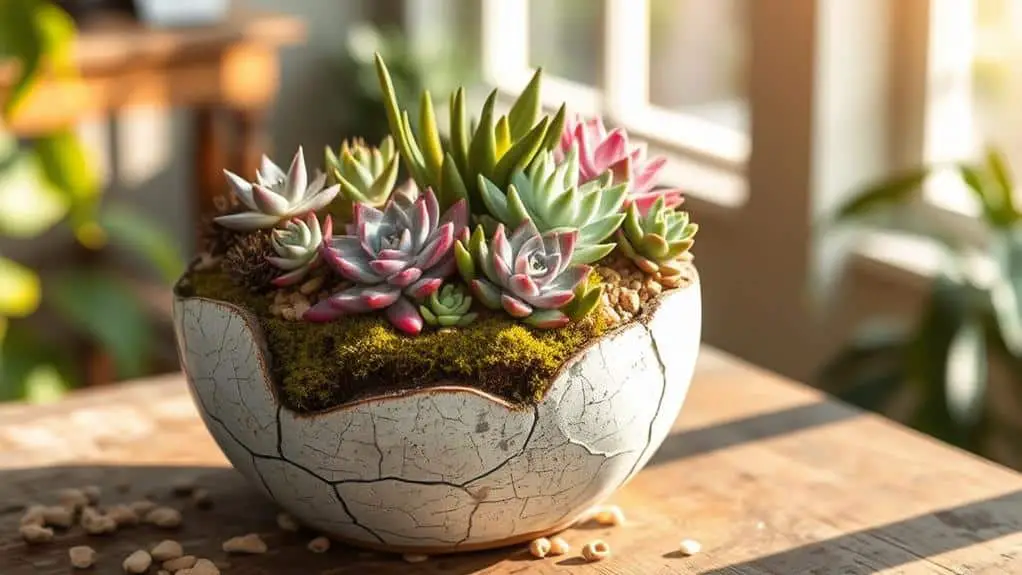
Repurposing cracked planters is a fantastic way to breathe new life into what might otherwise be discarded. You can transform broken pots into stunning succulent gardens. The intact base of the planter provides stability, while the broken pieces add unique visual interest. This eco-friendly approach reduces waste and enhances both indoor and outdoor spaces.
When repurposing, arrange the broken pieces creatively within the planter to create a structured display. Make sure the selected succulents have similar care needs to promote healthy growth. Succulent gardens thrive in well-draining soil, making them low-maintenance.
Repurposing broken pots not only beautifies your space but also offers a rewarding gardening experience. You'll feel proud knowing you've turned something broken into a beautiful, thriving succulent garden.
Selecting Succulent Varieties
Selecting the right succulent varieties can evoke a sense of artistry in your garden. When choosing succulent plants for your cracked planters, consider varieties like echeveria, sedum, haworthia, and crassula.
Echeveria minina, reaching about 3 inches, is perfect for smaller spaces. For a trailing effect, Sedum morganianum, or Burros Tail, offers thick, fleshy leaves that cascade beautifully. Sedum reflexum varieties like Blue Spruce or Angelina add vibrant colors and are very resilient in containers.
It's important to choose succulents with similar care needs to keep your garden low-maintenance and harmonious. This thoughtful selection of succulents guarantees that your cracked planters will transform into stunning, easy-to-care-for garden displays.
Soil and Watering Considerations

Creating a thriving succulent garden in a cracked pot starts with the right soil and watering practices.
First, use a well-draining soil mix made for succulents or cacti to guarantee your plants get the proper aeration and moisture control they need. Add a full layer of this potting mix to the base of your pot, spreading it evenly for a solid foundation.
Remember, letting the soil dry out completely between watering sessions is essential to prevent root rot. Succulents don't like being overwatered.
Position your garden in bright, indirect sunlight to promote growth without causing sunburn. Water thoroughly once or twice a week, depending on conditions, but avoid getting water on the leaves to prevent decay.
Arranging the Succulent Garden
When arranging your succulent garden, start by placing smaller succulents along the planter's crack to make the most of your space.
Use broken pot pieces creatively—they can add visual interest and support the plants.
Strategic Plant Positioning
Strategic plant positioning is essential for maximizing the visual appeal and health of your succulent garden, especially when dealing with a cracked pot.
Here's how to arrange it:
- Position succulents along the crack: This utilizes the space effectively, encouraging both vertical and horizontal growth.
- Stack smaller succulents compactly in the lower sections: This allows larger varieties to spread out in the top layer, creating a balanced arrangement.
- Incorporate broken pot pieces: These serve as decorative elements and provide structural support for the succulents along the crack.
- Use a variety of succulent species: Choose ones with similar care requirements to enhance visual interest and guarantee they thrive together.
Creative Pot Fragment Use
With your succulent garden's strategic plant positioning set, let's explore how broken pot fragments can elevate your arrangement. Using broken pieces creatively can add both support and visual interest. For instance, place smaller, lower-growing plants at the base of the crack for stability. Arrange taller plants using shards as support structures. This not only helps the plants but also makes your garden look unique.
Here's a quick table to guide you:
| Pot Fragment Use | Benefit |
|---|---|
| Support for tall plants | Prevents toppling |
| Base decoration | Adds visual interest |
| Edge arrangement | Encourages dynamic growth |
| Root protection | Maintains healthy roots |
| Pebble addition | Enhances texture and drainage |
Enhancing Garden Aesthetics
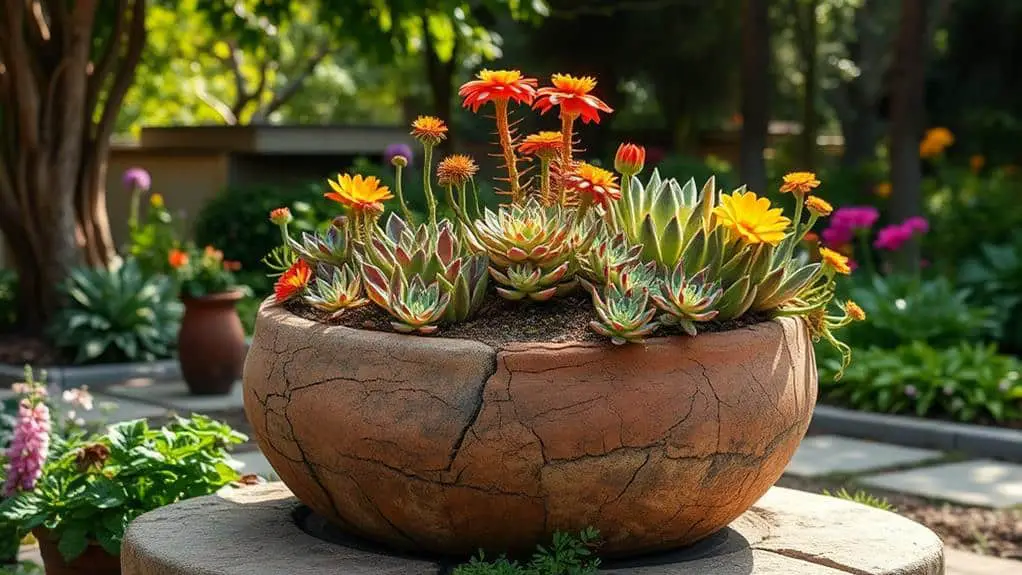
To enhance your succulent garden's aesthetics, try incorporating broken pot fragments into your design for a unique touch.
Experiment with different arrangements, like placing a half pot on its side to create interesting angles and encourage vertical growth.
Balance the colors and shapes of your succulents to create a harmonious and eye-catching display.
Incorporate Broken Pot Fragments
Transforming a cracked pot into a succulent garden offers a fantastic opportunity to enhance your garden's aesthetics by incorporating broken pot fragments. By doing so, you can create unique visual interest and give your garden a distinctive look.
Here's how you can use those fragments effectively:
- Larger shards: Position them strategically to provide stability and serve as a backdrop for your succulents.
- Smaller pieces: Use these to fill gaps and add texture, mimicking natural rock formations.
- Pebbles and river rocks: Add these alongside pot fragments to enhance design and aid in drainage.
- Different orientations: Experiment by placing pieces at angles or stacking them to create a dynamic, eye-catching display.
Your cracked planter can turn into a beautiful, layered succulent haven!
Experiment With Unique Arrangements
When experimenting with unique arrangements for your succulent garden, you'll discover that blending different cracked planters of varying sizes and shapes can create a stunning visual display.
I recommend placing a half pot on its side. This allows for vertical growth, adding dimension and interest to your succulent arrangement.
Don't hesitate to use broken pot pieces creatively; they can enhance texture and structure.
Regularly adjusting your arrangement by repositioning plants or adding new succulents keeps the garden fresh and engaging throughout the seasons.
Experimenting with these elements will help you create a cohesive, eye-catching display that brings endless enjoyment.
Balance Colors and Shapes
Balancing colors and shapes is key to enhancing the aesthetics of your succulent garden.
I like to mix and match different succulents to create a visually engaging display. Here's how you can do it:
- Colors: Choose succulents with contrasting colors, like vibrant pinks and deep greens, to create dynamic arrangements.
- Shapes: Incorporate various shapes and sizes, such as the rosette form of echeveria and the trailing nature of burros tail.
- Complementary Schemes: Pair cool-toned succulents like haworthia with warm-toned varieties like sedum for a harmonious look.
- Height Arrangement: Place taller succulents at the back or center and shorter ones at the front to balance the visual layout.
Materials Needed
To get started on your succulent garden from a cracked pot, you'll need a few essential materials. First, find a cracked-planter with an intact base and some shards. This will provide structure for your succulent garden. Next, use a moistened cacti soil mix or blend lightweight soil with clean sand to guarantee proper drainage. Gather six or more assorted succulent plants, like echeveria, sedum, or haworthia to create a visually appealing arrangement. You'll also need bamboo skewers and garden shears or clippers for securing plants and making precise cuts. Finally, clean pebbles or river rocks can be added for aesthetic appeal and extra drainage.
| Material | Purpose |
|---|---|
| Cracked-planter | Structure for the succulent garden |
| Cacti soil mix | Guarantees proper drainage |
| Assorted succulents | Visual appeal |
Potting Mix Application
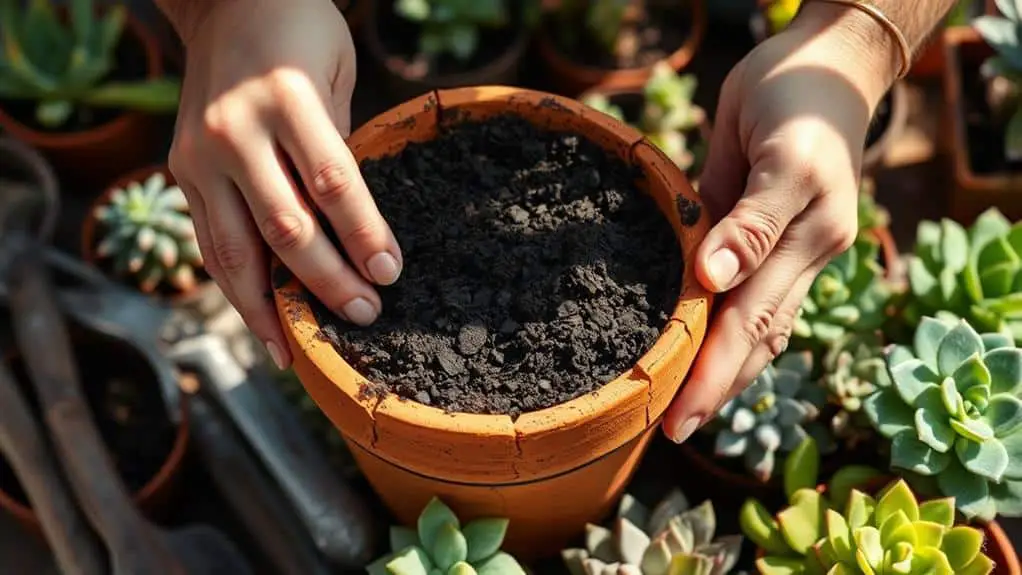
When you start, press a well-draining potting mix into the base of the cracked pot to give your succulents a strong foundation.
Make sure to evenly spread the mix along the broken edge and build it higher at the back for stability and a nice look.
This balanced soil distribution will support the roots and help prevent any air pockets.
Firm Potting Mix Foundation
A solid foundation is key when creating a succulent garden in a cracked pot. To start, make sure you firmly press the potting mix into the base to create a firm potting mix foundation. This foundation will support the plants and prevent them from toppling over.
Here's a simple guide to help you:
- Firmly press the soil into the base.
- Fill along the broken edge at the front, packing the soil well.
- Build the soil higher at the back for stability and a gradual slope.
- Ensure even distribution to avoid air pockets and support healthy roots.
Soil Distribution Balance
As you start applying the potting mix, pay close attention to how the soil is distributed throughout the cracked pot. First, press the soil firmly into the base to create a solid foundation.
Then, add soil to the cracked edge at the front to support the plants and form a visually appealing group. You need to know that building the soil higher at the back enhances stability and creates a tiered effect.
Make certain the potting mix is evenly spread to support the succulents' roots and avoid air pockets. A solid base will make it easier to arrange and secure your plants.
This balance guarantees your succulent garden thrives beautifully.
Plant Arrangement
Carefully arranging your succulents in a cracked pot can transform it into a stunning garden centerpiece. Start by gently separating the clumps of succulents to distribute them evenly.
Here's a step-by-step guide to help you:
- Begin by placing the succulents at the lowest point of the plant pot, overlapping edges for fullness.
- Firmly press the roots into the potting mix, backfilling with soil to eliminate air pockets.
- Strategically place the shards along the crack, allowing succulents to grow vertically and horizontally.
- Incorporate broken pot pieces and decorative stones around the succulents for added visual interest and support.
Incorporating Pot Fragments
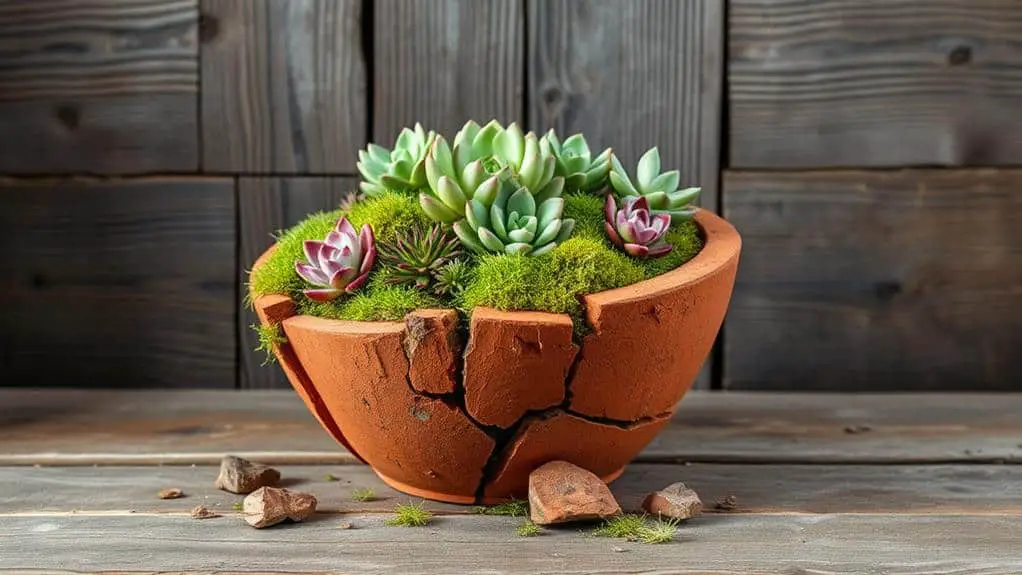
Wondering how to make the most of those pot fragments? I've got some great tips for you.
Place a large shard inside the cracked-planter garden to support your succulents. Position the broken edge at the base of your topmost plants to create a retaining wall effect, which helps keep the soil in place.
Press the pot fragment firmly without damaging any roots; this guarantees secure growth. Backfill around the shard with potting mix to add stability and eliminate air pockets that could harm your plants' health.
Use multiple fragments creatively throughout your arrangement. It adds interesting textures and makes the most of your cracked pot.
These steps cater to your plants' care needs and create a stunning garden.
Final Touches and Maintenance
Now that you've creatively incorporated pot fragments into your succulent garden, let's focus on those final touches and ongoing maintenance to keep it thriving.
First, press the root balls, shards, and soil firmly to guarantee stability and eliminate air pockets.
Next, follow these steps to maintain your garden:
- Use bamboo skewers to anchor small pots through their drainage holes, trimming them to stay below the soil line.
- Add a layer of clean pebbles or river rocks on top of the soil for aesthetic appeal and better drainage.
- Water thoroughly once or twice a week, letting the soil dry completely between waterings.
- Regularly check for dead leaves or pests, trimming unhealthy parts to maintain the garden's health.
Frequently Asked Questions
How to Make a Broken Pot Succulent Garden?
I love creative repurposing! Start by ensuring your pot's base is stable. Choose well-draining soil and assorted succulents. Arrange them compactly along the crack. Use broken pieces for support and pebbles for design inspiration. Enjoy!
How Do You Make a Succulent Garden in a Pot?
When making a succulent garden in a pot, I prioritize succulent care, pot drainage, and plant selection. I choose a pot with good drainage, use well-draining soil, and select succulents with similar care needs to guarantee success.
How Do You Plant Succulents in a Glass Pot?
When planting succulents in a glass pot, I start with drainage importance by adding stones at the bottom. Pot selection's key, and I use well-draining soil. Proper succulent care includes placing them in bright, indirect sunlight.
Can You Plant a Plant in a Cracked Pot?
You can definitely plant in a cracked pot. I focus on cracked pot care by using succulent types that thrive in well-draining soil. Implementing drainage solutions like pebbles helps prevent root rot and guarantees healthy growth.
Conclusion
You've got this! Transforming a cracked pot into a beautiful succulent garden is both fun and eco-friendly. Remember to choose the right succulents, guarantee good soil drainage, and let your creativity shine when arranging the pieces. By incorporating pot fragments and paying attention to watering needs, your garden will thrive. Don't worry if it's not perfect—gardening is all about experimenting and learning. Enjoy the process, and soon you'll have a stunning display to be proud of!

